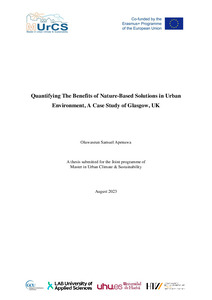Quantifying The Benefits of Nature-Based Solutions in Urban Environment : a Case Study of Glasgow, UK
Apenuwa, Oluwaseun (2023)
Apenuwa, Oluwaseun
2023
All rights reserved. This publication is copyrighted. You may download, display and print it for Your own personal use. Commercial use is prohibited.
Julkaisun pysyvä osoite on
https://urn.fi/URN:NBN:fi:amk-2023111329256
https://urn.fi/URN:NBN:fi:amk-2023111329256
Tiivistelmä
Nature-based solutions (NBS) are innovative and sustainable approach towards creating a resilient city. In the case of Glasgow city council, this research aimed to value the eco-services provided with a focus on trees and Artificial Floating Wetlands(AFWs) in order to promote better management and investment. A multi method methodological approach was adopt to achieve this goal. Spatial coverage of the NBS was use to analysis their coverage with specific use of Landsat 8 imagery for year 2013, 2020 and 2023 with ARCGIS application. The valuation of tree was carried using i-Tree Canopy and existing literature for AFW. Management issues of these infrastructure was carried through data collection from interview with relevant stakeholders. Glasgow spatial analysis showed a reduction in canopy cover from 18.4% to 16.1% between 2013 and 2023 of the total land area within each of the 23 council wards, with most of them experiencing reduced canopy cover and the city center being the most deprived among them all. Glasgow tree eco-services estimation covered carbon sequestration, avoided runoff and air quality, this was valued at about £5 million annually. Trees also serve as carbon sink; Glasgow city tree stock helps the city to store over 200 kilotons of carbon valued at over £55 million. AFW on the other hand has limited presence in the city offering carbon storage and water treatment eco-services valued at £346,410 which is more than twice the cost of installation. Its use is limited due to low awareness and rigid planning laws despite it simplified design and management. Conclusively, the lack of a detailed policy document (Forestry and Woodland strategy) has played a significant role in the poor management of trees, the increase urban density and disease are a major setback to increasing canopy cover in the city. Both NBS are important urban infrastructure and unique in their respective use, they are expected to complement each other to achieve urban resilience.
